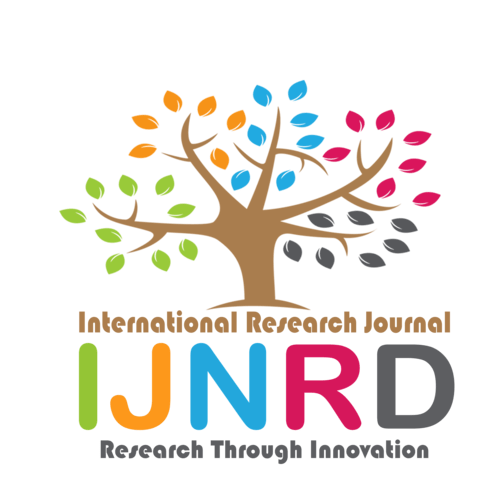|
|||||||||||||||

|
INTERNATIONAL JOURNAL OF NOVEL RESEARCH AND DEVELOPMENT International Peer Reviewed & Refereed Journals, Open Access Journal ISSN Approved Journal No: 2456-4184 | Impact factor: 8.76 | ESTD Year: 2016 Scholarly open access journals, Peer-reviewed, and Refereed Journals, Impact factor 8.76 (Calculate by google scholar and Semantic Scholar | AI-Powered Research Tool) , Multidisciplinary, Monthly, Indexing in all major database & Metadata, Citation Generator, Digital Object Identifier(DOI) |
||||||||||||||
Issue: May 2024
Volume 9 | Issue 5
Review Result and Publication of Paper within : 2-3 days
Click Here For more DetailsFor Authors
Forms / Download
Published Issue Details
Editorial Board
Other IMP Links
Facts & Figure
Impact Factor : 8.76
Issue per Year : 12
Volume Published : 9
Issue Published : 96
Article Submitted :
Article Published :
Total Authors :
Total Reviewer :
Total Countries :
Indexing Partner
Join RMS/Earn 300
Licence
This work is licensed under a Creative Commons Attribution-NonCommercial 4.0 International License







|
Published Paper Details
|
|
| Paper Title: | Teaching Segmental Features, Suprasegmental Features and Discourse Markers for Developing Listening Skills |
| Authors Name: | Rabin Kumar Das |
| Download E-Certificate: | Download |
| Author Reg. ID: |
IJNRD_189165
|
| Published Paper Id: | IJNRD2303273 |
| Published In: | Volume 8 Issue 3, March-2023 |
| DOI: | |
| Abstract: | Listening is an aural receptive skill involving a chain of complex processes. One cannot acquire competence in speaking without developing listening skill. Listening is an important language skill involving cognitive and metacognitive processes to decode the speech sounds and speech. The subskills of listening must be mastered to become a good listener and a good speaker. Perception skills and language skills are the subskills or micro-skills of listening and constitute the decoding process. By dint of the decoding process, the acoustic input is converted into the standard units of the language such as speech sounds, words, phrases and sentences. In order to acquire listening skill, one must recognize and learn how to discriminate between speech sounds, identify word boundaries or junctures in connected speech, recognize intonation patterns, identify discourse markers, etc. The speech sounds which we produce with the help of our speech organs are called segments which include vowels and consonants. The features of these segments are called segmental features. The features which go beyond the segments are known as suprasegmental features. Discourse markers are those devices which make clear the connection between what we are going to say or utter and what came before e.g. ‘anyway’, ‘however’, etc. Teaching segmental features, suprasegmental features and discourse markers can be done through the integrated approach or in isolation as far as the teaching methodology is concerned. Appropriate and relevant tasks are set to teach the features and discourse markers. Repetition exercises can help the students master the speech sounds. Words are played on a tape recorder and the students repeat the words individually. Various listening exercises can be given to the students to assess their knowledge about discriminating sounds like listening to the pairs of words and identifying speech sounds, etc. Discourse markers are used to indicate our attitude to the truth of what we are saying (‘I think’, ‘I suppose’, ‘frankly’, ‘sort of ‘, etc.), to show what kind of communication is going on (‘after all’ in persuading, ‘I’m afraid’ in polite refusal, ‘actually’ in breaking news,), etc. Integration of listening skill with speaking skill and writing skill is an effective means of teaching segmental and suprasegmental features, and discourse markers. |
| Keywords: | decoding, segments, discourse markers, exercises, methodology, integration. |
| Cite Article: | "Teaching Segmental Features, Suprasegmental Features and Discourse Markers for Developing Listening Skills ", International Journal of Novel Research and Development (www.ijnrd.org), ISSN:2456-4184, Vol.8, Issue 3, page no.c646-c665, March-2023, Available :http://www.ijnrd.org/papers/IJNRD2303273.pdf |
| Downloads: | 000118763 |
| ISSN: |
2456-4184 | IMPACT FACTOR: 8.76 Calculated By Google Scholar| ESTD YEAR: 2016 An International Scholarly Open Access Journal, Peer-Reviewed, Refereed Journal Impact Factor 8.76 Calculate by Google Scholar and Semantic Scholar | AI-Powered Research Tool, Multidisciplinary, Monthly, Multilanguage Journal Indexing in All Major Database & Metadata, Citation Generator |
| Publication Details: |
Published Paper ID:IJNRD2303273 Registration ID: 189165 Published In: Volume 8 Issue 3, March-2023 DOI (Digital Object Identifier): Page No: c646-c665 Country: -, -, - Research Area: Engineering Publisher : IJ Publication Published Paper URL : https://www.ijnrd.org/viewpaperforall?paper=IJNRD2303273 Published Paper PDF: https://www.ijnrd.org/papers/IJNRD2303273 |
| Share Article: | |
|
Click Here to Download This Article |
|
| Article Preview | |
|
|
|
Major Indexing from www.ijnrd.org
| Semantic Scholar | Microsaoft Academic | ORCID | Zenodo |
| Google Scholar | ResearcherID Thomson Reuters | Mendeley : reference manager | Academia.edu |
| arXiv.org : cornell university library | Research Gate | CiteSeerX | PUBLON |
| DRJI | SSRN | Scribd | DocStoc |
ISSN Details
 |
 |
ISSN: 2456-4184
Impact Factor: 8.76 and ISSN APPROVED
Journal Starting Year (ESTD) : 2016
DOI (A digital object identifier)
Conference
Open Access License Policy
Important Details
Social Media
| Copyright © 2024 - All Rights Reserved - IJNRD |












Facebook Twitter Instagram LinkedIn